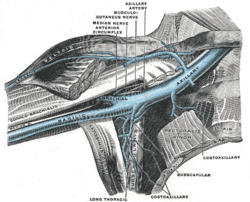Axillary vein
| Axillary vein | |
|---|---|
 Anterior view of right upper limb and thorax - axillary vein and the distal part of the basilic vein and cephalic vein. | |
| Details | |
| Drains from | axilla |
| Source | basilic vein, brachial veins, cephalic vein |
| Drains to | subclavian vein |
| Artery | axillary artery |
| Identifiers | |
| Latin | vena axillaris |
| MeSH | D001367 |
| TA98 | A12.3.08.005 |
| TA2 | 4963 |
| FMA | 13329 |
| Anatomical terminology | |
In
human anatomy, the axillary vein is a large blood vessel that conveys blood from the lateral aspect of the thorax, axilla (armpit) and upper limb toward the heart
. There is one axillary vein on each side of the body.
Structure
Its origin is at the lower margin of the
brachial vein.[1]
This large vein is formed by the
brachial vein and the basilic vein.[2] At its terminal part, it is also joined by the cephalic vein.[3] Other tributaries include the subscapular vein, circumflex humeral vein, lateral thoracic vein and thoraco-acromial vein.[4] It terminates at the lateral margin of the first rib, at which it becomes the subclavian vein.[1]
It is accompanied along its course by a similarly named artery, the axillary artery, which lies laterally to the axillary vein.[5]
Additional images
-
Intercostal nerves, the superficial muscles having been removed.
-
Axillary vein
-
Axillary vein
References
- ^ ISBN 978-0-443-06701-3, retrieved November 3, 2020
- ^ Moore, Keith L. et al. (2010) Clinically Oriented Anatomy, 6th Ed, p.718
- ^ Moore, Keith L. et al. (2010) Clinically Oriented Anatomy, 6th Ed, p.718
- ^ Moore, Keith L. et al. (2010) Clinically Oriented Anatomy, 6th Ed, fig.6.16
- S2CID 382483, retrieved November 3, 2020
External links
- lesson3axillaryart&vein at The Anatomy Lesson by Wesley Norman (Georgetown University)



